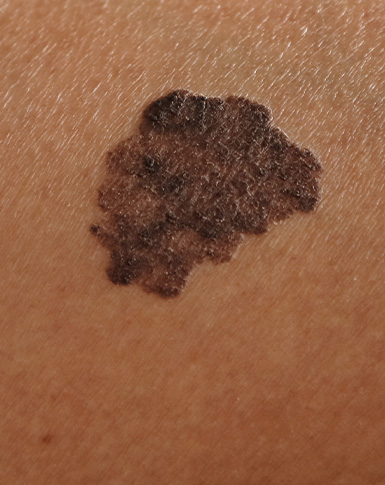
What Is Melanoma?
In the United States, melanoma is the fifth most common cancer in men and the sixth most common cancer in women. It is estimated that over 100,000 new cases of melanoma are diagnosed each year. Melanoma is the most aggressive and dangerous type of skin cancer. If it is not caught early, it can be fatal. For this reason, it is important to have moles examined annually, particularly if they are unusual or changing or if you have a personal or family history of melanoma. At Snyder Dermatology, led by board-certified dermatologist Dr. Renee Snyder, we examine moles to ensure they are healthy. Melanoma generally begins with a mole (either existing or new) that has changed and shows signs of irregularity. In most patients, this means the mole has become very dark in color, has irregular borders, and has begun to grow in size, itch, or bleed.
What Causes Melanoma?
Melanocytes (pigmented cells in the epidermis) may turn malignant when exposed to sun or ultraviolet light, which causes DNA damage to the cells. This DNA damage allows cells to mutate and grow rapidly, creating melanoma. Some people may also have an inherited predisposition for melanoma, making DNA damage from UV light particularly dangerous. Because the vast majority of melanomas can be seen on the skin, consistent mole checks and self-exams are very important to aid in early diagnosis and treatment. Call Snyder Dermatology today to schedule your skin cancer screening appointment.

Symptoms of Melanoma
Malignant lesions can be challenging to recognize, especially to the untrained eye. Having regular skin cancer screenings by a trained, board-certified dermatologist is essential. We educate our patients on the presenting symptoms of melanoma with the ABCDE rule. These are the signs to look for in moles that may signal the lesion is concerning and include:
-
- A: Asymmetrical mole (one side is larger than the other, not round or oval in shape)
-
- B: Borders on the mole (a malignant mole will not have a defined, smooth border)
-
- C: Color (a malignancy will be various colors throughout the mole or very dark)
-
- D: Diameter (benign moles usually stay small — moles larger than a pencil eraser are concerning)
-
- E: Evolving (cancer cells in a malignant mole will keep changing and growing)
While some benign moles or freckles may have some of these characteristics, you should always make an appointment with your dermatologist to have spots with these concerning features examined.
CONTACT US
Have questions or want to schedule an appointment? Contact us today to speak with a member of the Snyder Dermatology team. We’re here to address your concerns with compassionate and effective care.
CONTACT

Board-Certified Dermatologists
MEET OUR DOCTORS
Snyder Dermatology is the premier practice for medical and cosmetic dermatology in Austin, TX. Centrally located, our dynamic team of board certified dermatologists focus on providing patients with the most advanced medical care and treatment options. Our practice is distinguished by our compassion, our desire to fully understand our patients’ needs, and our commitment to being good stewards in the communities where we live and work.
How to Treat Melanoma
Snyder Dermatology has multiple board-certified dermatologists with specialized training to screen for and treat skin cancer. Treatment for melanoma is based on the type and stage of melanoma, size, and location. Our experienced providers at Snyder Dermatology will work closely with you and discuss the appropriate treatment, which usually includes excision with a standard margin. Our team will work with cancer specialists to assist in your treatment if needed. Additional diagnostic testing may be needed in certain cases, such as a PET or CT scan, blood work, and lymph node biopsy.
Schedule a Consultation
Melanoma is one of the most aggressive types of cancer you can develop. Our goal at Snyder Dermatology is to educate our Austin, Downtown Austin, and West Lake Hills, TX, patients about skin cancer development and prevention and to diagnose and treat concerning lesions as early as possible. Not only do we assess for melanomas and skin cancers, but we also educate you about the measures needed to protect your skin from the sun. If you notice changes in your moles or other skin lesions, please make an appointment at our Austin, TX, office today.




